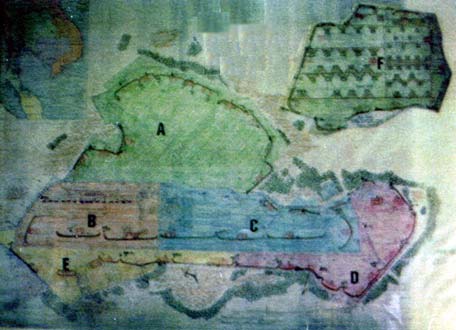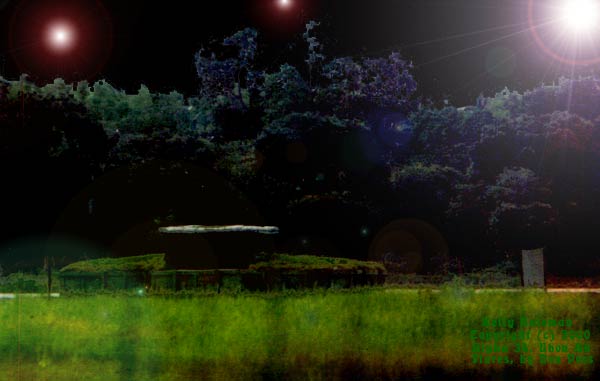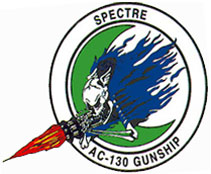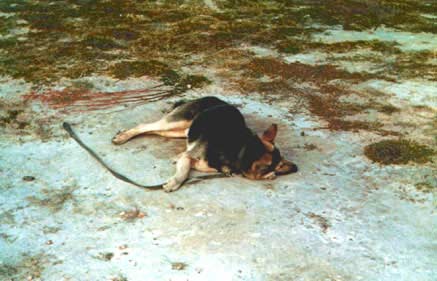 July 28, 1969 July 28, 1969
The time was 0130 hours, 28 July 1969 and it was starting to rain again at Ubon RTAFB. USAF Sentry Dog Handler A1C Kenneth D. O'Dell and his Sentry Dog Sheafer (X846) were posted on ub's northeast perimeter at post Echo-77. It had been raining at Ubon off and on all night, but now the rain was on again, so it was time for rain gear. As A1C O'Dell put on his rain top he was fired on by three sappers, who were approximately 30 yards inside the perimeter fence and lying only 20 yards away in the tall grass. He and Sheafer were now between the intruders and the perimeter fence, blocking the sapper's escape route. Running toward the perimeter concertina wire the sappers fired several more bursts in O'Dell's direction. Now the sappers were within 10 yards of the perimeter fence.
Photo: Wall map at Ubon RTAFB Sentry Dog Kennels,
showing A, B, C, D, E, and F Sectors of the base.
After releasing his dog, A1C O'Dell advised CSC (Central Security Control) that Echo-77 was receiving hostile fire and was under attack. In an effort to return fire the airman dropped to the prone position. He now found his line of fire blocked by a mound of dirt between him and the intruders. Rising to a kneeling position O'Dell found his line of fire again blocked but this time by his dog Sheafer who was pursuing the intruders as they made their way toward the fence. O'Dell then ran to a new position near the fence where he was again fired upon as the sappers escaped through the perimeter wire.
CSC radioed all USAF 81mm mortar pit crews to fire flare illumination to help to locate the hostile force. Echo 2 and Bravo 2 SAT teams arrived at Echo-77 and deployed at the point where the sappers had exited the base. As the SAT Teams deployed both A1C O'Dell and his dog Sheafer were found to be wounded, and were quickly evacuated to the base hospital. A1C O'Dell was wounded in the left knee and Sheafer was hit in the left shoulder. Both would recover.
 Photo: View looking over Machinegun Bunker, Alpha-34, toward the jungle on the perimeter, Ubon RTAFB, Thailand. Photo: View looking over Machinegun Bunker, Alpha-34, toward the jungle on the perimeter, Ubon RTAFB, Thailand.
The Sapper Team had penetrated onto the base, planted their satchel charges and were in the process of escaping when they encountered the K-9 Sentry. At 0200 hours several "Blind Bat" flare ships dropped flares over the base while a sweep was made by the SAT's and QRT's for more sappers and any planted explosive charges. At 0215 hours, several C-47 aircraft parked on the taxiway near the Base Operations building were rocked by detonated satchel charges planted earlier by the sapper team. Nineteen flares were then dropped by airborne AC-130 flare ships over Echo and Delta sectors as SAT, QRT and K-9 Security teams swept these areas for more hidden enemy personal and explosives. Luckily none were found. No enemy were killed or captured and the damage to the parked aircraft was serious but was repaired quickly. It had been a long night but this attack was over. The following day ground searches of the on base and off base perimeter turned up various items discarded by the sappers. Found was black clothing, unexploded Satchel charges, 9mm NVA ammo clips, and other various items of Chinese and North Vietnamese military equipment. The sappers had understandably been in a big hurry and it showed. They left a trail of abandoned equipment as they escaped across the runway toward the perimeter fence and out into the jungle beyond.
Between 1969 and the early 1970's an escalation in U.S. ground and air combat activity in the Vietnam War brought a like response from the North Vietnamese. As before, the combat aircraft from bases in Thailand and Vietnam were greatly damaging to the enemy with day and night air strikes. The USAF bases in Vietnam and Thailand again became a prime target for the VC and NVA Sapper Teams whose goal was to stop the these aircraft from leaving the ground. Ubon airfield was no exception.
On the afternoon of November 26, 1969 at the outskirts of Ubon City, Thailand, a fifteen year old Thai boy was playing at his home next door to the abandoned Ubon distillery. While playing, he observed three armed men dressed in camouflage fatigues move through the distillery grounds and quickly disappear into the dense jungle that surrounded his neighborhood. That same day, three armed men had seized food from five young boys as they played outside their village fourteen kilometers northeast of Ubon Air Field. After threatening the boys those men quickly disappeared into the nearby jungle.
During the several months preceding these two incidents, local Thai and Vietnamese informants had provided information to the Thai Air Force and the USAF OSI (Office of Special Investigation) regarding the movement of communist insurgents and their supplies into the area within a thirty kilometer radius of Ubon Air Field. The specific information then was "three brave North Vietnamese Sapper teams", along with arms and explosives, were infiltrated from North Vietnam through Laos into the area of a Vietnamese Village located near Ubon City and Ubon Royal Thai Air Force Base (Ubon Air Field). The weapons and explosives were reportedly to be used for sabotage of communications facilities, airfields, Thai Government Buildings and an unnamed American Air Base in Thailand. However, the location of this enemy supply cache was not known by any of the informants. Many reports such as these were received monthly by the Thai an U.S. Intelligence gathering units. Intelligence would then analyze the information in these reports and pass it on to the affected USAF and US Army units and commands stationed in Thailand.
January 13, 1970
Unlike the 10 weeks preceding the July 1969 attack, the month of January, 1970 saw a decrease in the number of reports of insurgent activity in the thirty kilometer area surrounding Ubon airfield. Although the number of insurgent reports had fallen the violence of the encounters had escalated. One such report received during this time period stated that the village chief of Brut Ha Knew, II kilometers from the airfield was questioned, then beaten by two unknown Vietnamese men after failing to Satisfactorily answer their questions regarding the defenses and armament at Ubon RTAFB. They then left the village after firing several shots over the heads of the remaining witnesses.
The number of encounters between armed information seeking, insurgents and the local population had dropped off significantly, however this was about to change.
The day before the attack, at 2115 hours on January 12, 1970, the Thai Provincial Police in Ban Pratham reported to Ubon CSC that an armed force of 16 men, dressed in dark clothing, was traveling in the direction of Ubon Air Field. The report stated that this group had disappeared into the jungle before they could be challenged. CSC then issued a Condition Yellow Alert for the base at 2121 hours.
All was quiet until 0201 hours on January 13, 1970. It was then that the Echo Sector SAT Team, posted on the northeast perimeter of the base, radioed Security Control that they could hear automatic weapons fire coming from the vicinity of mortar pit, Echo-78. The mortar pit crew at Echo-78 then confirmed by radio to CSC that they were under attack.
Airman Larry Bridges, the K-9 Sentry at Echo-75, also radioed that he was being fired on by 5 or 6 unidentified persons, approximately 10-15 yards inside the perimeter fence and 30 yards away from his position in front of machinegun bunker Echo-44. K-9 handler Larry Bridges later stated that his dog, King (A642), had alerted on the intruders as they peered over a slight mound of dirt. At the same time the sappers spotted him and his dog, and both had begun to fire at each other simultaneously.
K-9 handler Airman Larry Bridges' fire was supported by the M60 machinegun and M16 being fired by the mortar pit crew at Echo-78. Four of the intruders then ran in a low crouch toward the active runway and the aircraft parked on the opposite side. At 0202 hours, Red Option I was implemented by CSC. The attack had started and the chase was on.
As the 4 intruders drew abreast of K-9 Sentry Echo-75, he released his dog. USAF Sentry Dog King (A642) ran to attack the sappers as he had done so many times before in training with his handler. Two of the sappers then ran west following the perimeter fence in front of mortar pit Echo-78. Echo-78 now ceased firing toward the insurgents running toward the runway and turned their fire toward the perimeter fence and the two escaping sappers. The Machine Gunner in bunker Echo-36 also turned his fire toward the perimeter as did K-9 Sentry Echo-75, who was now pinned down in front of bunker Echo-36 without his dog. By this time the sounds of gunfire and the loud hurriedly shouted radio transmissions to CSC could be heard by all on duty base security forces. Every Security Policeman and Thai Guard now knew that the base was under full attack.
At 0203 hours Echo Area SAT radioed CSC that a large explosion had just occurred on the northeast perimeter fence line. This Explosion came from in front of bunker Echo-36. Echo-36 had fired an M-79 grenade at point blank range, hitting one of the escaping sappers who was carrying Satchel charges strapped to his body. His body was literally blown apart. His hair and scalp hanging on the concertina wire and one leg found in front of bunker Echo-36 were all that remained of this individual sapper.
 CSC now radioed all base security forces that the Thai Army had responded and were converging on the outside base perimeter of the base. At 0205 hours Bravo Area SAT radioed that they were receiving fire from four intruders running west across the runway toward the AC-130 Specter Gun Ships parked adjacent to Taxiway-3. Bravo SAT then returned this fire with their M60 machine gun mounted on their mobile jeep. At the same time K-9 Sentry Bravo-72, Sgt Thomas Cartwright Jr., posted east of the AC-130 parking area, released his dog Jody (89X1). He then dropped to the prone position and opened fire on the sappers with his M16. One of the sappers fell wounded. Seeing this the three remaining insurgents turned their fire on Sgt Cartwright and K-9 Jody. Sgt Cartwright fell wounded taking one round in the leg, and Jody fell with one round in his neck. CSC now radioed all base security forces that the Thai Army had responded and were converging on the outside base perimeter of the base. At 0205 hours Bravo Area SAT radioed that they were receiving fire from four intruders running west across the runway toward the AC-130 Specter Gun Ships parked adjacent to Taxiway-3. Bravo SAT then returned this fire with their M60 machine gun mounted on their mobile jeep. At the same time K-9 Sentry Bravo-72, Sgt Thomas Cartwright Jr., posted east of the AC-130 parking area, released his dog Jody (89X1). He then dropped to the prone position and opened fire on the sappers with his M16. One of the sappers fell wounded. Seeing this the three remaining insurgents turned their fire on Sgt Cartwright and K-9 Jody. Sgt Cartwright fell wounded taking one round in the leg, and Jody fell with one round in his neck.
By this time, three USAF 81mm mortar pits were providing continuous flare illumination that cast a red glow over the base and the events that were unfolding around the running battle for the AC-130 aircraft. Barrel flares, pointing outward along the perimeter of the base, were now ignited to better see any enemy that might be staging for another attack, or still crawling through the concertina wire. Illumination made the black night almost as bright as day.
At 0206 hours, Bravo SAT Leader radioed CSC that his SAT rider had killed two of the attackers. As Sgt Cartwright and his K-9 Jody lay wounded, Bravo SAT took up the pursuit of the remaining hostile force headed directly for the Specter Gunships! CSC had dispatched a QRT to the area, and now the Bravo-SAT and the QRT were involved in a heavy firefight less than 50 yards west of the sappers' targeted AC-130s! These 2-man SAT Teams were equipped with a standup mounted M60 machinegun mounted in the back floorboard of their jeep. The SAT rider could maintain a constant fire as the driver pursued the enemy force. They were also equipped with M16's and Smith and Wesson .38 cal. Combat Masterpieces revolvers as side arms.
At 0224 hours the QRT radioed CSC that all remaining insurgents had been killed in the southwest corner of the AC-130 parking area--with no casualties from the QRT or Bravo SAT.
But tragedy was was only minutes away.
 All known sappers now lay dead, only yards from their targets. One dead sapper was found behind the GCA generator 20 yards from the parked aircraft. This sapper was later found to be the one wounded by K9 Sentry Sgt Cartwright. Another body found was discovered, that of wounded Echo-75 Sentry Dog King. King, although receiving a shoulder wound from the sappers during the early moments of the attack, had pursued the VC across the runway and renewed his attack during the final firefight and received a second wound from a crawling sappers. Wounded, yet still determined to attack the sappers, King continued crawling in wounded-pursuit, and was mistakenly killed by the QRT Team who mistook him for a hiding sapper. All known sappers now lay dead, only yards from their targets. One dead sapper was found behind the GCA generator 20 yards from the parked aircraft. This sapper was later found to be the one wounded by K9 Sentry Sgt Cartwright. Another body found was discovered, that of wounded Echo-75 Sentry Dog King. King, although receiving a shoulder wound from the sappers during the early moments of the attack, had pursued the VC across the runway and renewed his attack during the final firefight and received a second wound from a crawling sappers. Wounded, yet still determined to attack the sappers, King continued crawling in wounded-pursuit, and was mistakenly killed by the QRT Team who mistook him for a hiding sapper.
At 0225 hours K-9 Sentry Sgt Cartwright and his dog Jody were evacuated for medical care. Both recovered from their wounds. C-123 aircraft from Ubon were now dropping parachute flares over the area and the base was swept by SAT and QRT teams for any remaining intruders. None were discovered. No aircraft were banned. This night the NVA sappers lost five men. Four sappers escaped. Their abandoned weapons and gear being found the next day in the jungle 40 yards outside the base perimeter. Unconfirmed reports by several local citizens placed from one to four suspicious persons fleeing northeast after the battle. The local population living in and around the Air Base and the Ubon area always cooperated with military authorities in passing on any information and early warning regarding suspicious activity outside and around the base. Through investigation after every incident of hostile activity directed toward the Air Base found that the attackers had no local support but were infiltrated and supplied from outside Thailand by the NVA or Laotian forces. |

